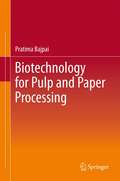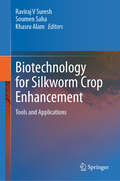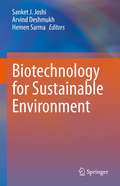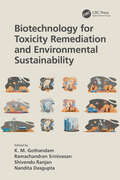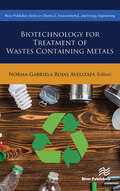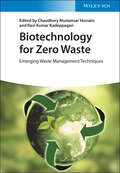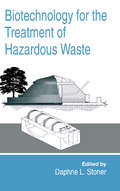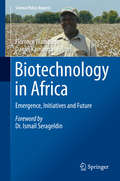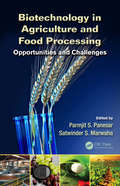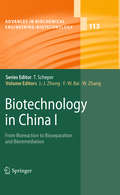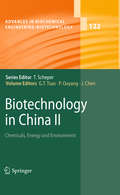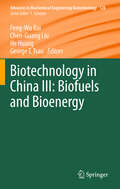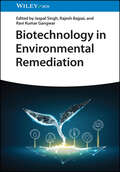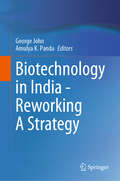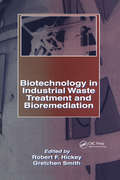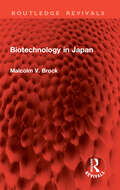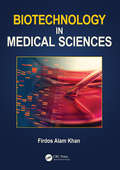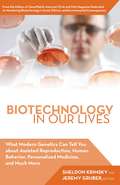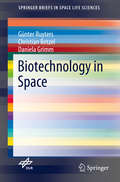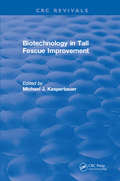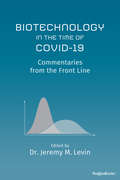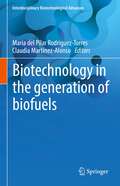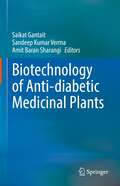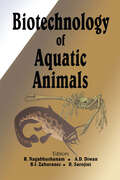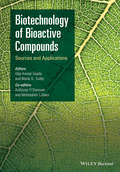- Table View
- List View
Biotechnology for Pulp and Paper Processing
by Pratima BajpaiThis book provides the most up-to-date information available on various biotechnological processes useful in the pulp and paper industry. Each of the twenty chapters covers a specific biotechnological process or technique, discussing the advantages, limitations, and future prospects of the most important and popular processes used in the industry. Topics covered include tree improvement, pulping, bleaching, deinking, fiber modification, biosolids management, and biorefining.
Biotechnology for Silkworm Crop Enhancement: Tools and Applications
by Raviraj V Suresh Soumen Saha Khasru AlamThe book introduces readers to the latest developments in biotechnological methods used for improving the cultivation of silkworms. The text focuses on implementing biotechnological approaches, ranging from basic to advanced techniques, on enhancing silk production, increasing abiotic stress resilience, improving disease tolerance, and developing resistance in silkworm crops. With the current climate crisis and growing demand for high-quality silk, biotechnological applications have become essential in addressing the urgent need to increase silk production. The field of sericulture has made significant breakthroughs, such as identifying DNA markers, linkage association, genome-wide association studies, generating mutants, and introducing transgenic silkworms. Developing silkworms with improved cocoon yield and disease resistance is crucial to boost silk production. The book covers fundamental principles and recent advancements and delves into various methodologies employed inseri-biotechnology for improving silkworm crops. These methodologies include next-generation sequencing for DNA sequencing, using molecular markers to enhance abiotic stress tolerance (specifically high temperature and humidity conditions), expression analysis, RNA interference, gene knockout approaches to bolster disease resistance, and transcriptomics to enhance economically significant parameters such as silk content. The book explains these topics in detail and includes contemporary research appraisals, extensive discussions, and an evaluation of the benefits and risks associated with the use of biotechnological tools. This book serves as an invaluable reference for researchers and academics in biotechnology, molecular biology, and sericulture while also serving as an informative starting point for budding researchers.
Biotechnology for Sustainable Environment
by Hemen Sarma Sanket J. Joshi Arvind DeshmukhThis book brings together the most recent advances from leading experts in the burgeoning field of environmental biotechnology. The contributing chapters adopt a multidisciplinary approach related to environmental aspects of agriculture, industry, pharmaceutical sciences and drug developments from plant and microbial sources, biochemical chemical techniques/methods/protocols involved in different areas of environmental biotechnology. Book also highlights recent advancements, newly emerging technologies, and thought provoking approaches from different parts of the world. It also discusses potential future prospects associated with some frontier development of biotechnological research related to the environment. This book will be of interest to teachers, researchers, biotechnologists, capacity builders and policymakers, and will serve as additional reading material for undergraduate and graduate students of biotechnology, microbiology and environmental sciences.
Biotechnology for Toxicity Remediation and Environmental Sustainability
by Shivendu Ranjan Nandita Dasgupta K. M. Gothandam Ramachandran SrinivasanEnvironmental issues such as ozone layer depletion, overpopulation, biodiversity loss, global warming, natural resource depletion, and so on affect every organism on the planet somehow. Environmental biotechnology applications can help to protect and restore the quality of the environment. The goal is to use biotechnology with other technologies and safety procedures to prevent, arrest, and reverse environmental degradation. Environmental biotechnology is one of the most rapidly expanding and practically useful scientific fields. Biochemistry, physiology and genetic research of microorganisms can be converted into commercially available technologies for reversing and preventing further deterioration of the earth's environment. Solid, liquid, and gaseous wastes can be altered either by recycling new by-products or by purifying to make the end product less harmful to the environment. Biotechnology for Toxic Remediation and Environmental Sustainability discusses the removal of pollutants by absorption techniques and recycling wastewater into valuable by-products and biofuels by microorganisms. Moreover, this book also addresses corrosion prevention by green inhibitors, uses electrochemical systems for renewable energy and waste recycling using microbes, and recent food safety and security trends in the food microbiome. On the other hand, this book also discusses therapy and treatments against antibiotic-resistant bacteria, anti-cancer and pharmacological properties of thymoquinone and preventive properties of zinc nanoparticles against stress-mediated apoptosis in epithelial cells. Features Covers all aspects of Biotechnological application in the environment Discusses sustainable technology for the wastewater treatment and value-added products from wastewater Focuses on research activities Green corrosion inhibitors, bio-electrochemical systems, food safety and security, and antimicrobial resistance The book is a valuable resource for the undergrad and graduate students, doctoral and post-doctoral scholars, industrial personnel, academicians, scientists, researchers, and policymakers involved in understanding and implementing applications of biotechnology for environmental toxic remediation.
Biotechnology for Treatment of Residual Wastes Containing Metals
by Norma Gabriela Rojas-AvelizapaBiotechnology for Treatment of Wastes Containing Metals addresses various aspects related to different wastes that have a metallic content and represent a serious risk for the environment and human health. These wastes, due to their physical and chemical characteristics, have been the object of studies which have led to the development of different technologies in recycling, reuse or adequate disposal, biotechnology being one of these alternatives. Biotechnology offers a range of options for the treatment of types of waste using microorganisms, biomass and their by-products. The mechanisms involved in these waste treatment processes are diverse and complex, and its optimization and efficiency is multifactorial.This text contains nine chapters related to the problem of the metal contamination in the environment as well as some of the different biotechnological alternatives that have been applied for the reduction and/or recovery of metal contamination.
Biotechnology for Zero Waste: Emerging Waste Management Techniques
by Chaudhery Mustansar Hussain Ravi Kumar KadeppagariBiotechnology for Zero Waste The use of biotechnology to minimize waste and maximize resource valorization In Biotechnology for Zero Waste: Emerging Waste Management Techniques, accomplished environmental researchers Drs. Chaudhery Mustansar Hussain and Ravi Kumar Kadeppagari deliver a robust exploration of the role of biotechnology in reducing waste and creating a zero-waste environment. The editors provide resources covering perspectives in waste management like anaerobic co-digestion, integrated biosystems, immobilized enzymes, zero waste biorefineries, microbial fuel cell technology, membrane bioreactors, nano biomaterials, and more. Ideal for sustainability professionals, this book comprehensively sums up the state-of-the-art biotechnologies powering the latest advances in zero-waste strategies. The renowned contributors address topics like bioconversion and biotransformation and detail the concept of the circular economy. Biotechnology for Zero Waste effectively guides readers on the path to creating sustainable products from waste. The book also includes: A thorough introduction to modern perspectives on zero waste drives, including anaerobic co-digestion as a smart approach for enhancing biogas production Comprehensive explorations of bioremediation for zero waste, biological degradation systems, and bioleaching and biosorption of waste Practical discussions of bioreactors for zero waste and waste2energy with biotechnology An in-depth examination of emerging technologies, including nanobiotechnology for zero waste and the economics and commercialization of zero waste biotechnologies Perfect for process engineers, natural products, environmental, soil, and inorganic chemists, Biotechnology for Zero Waste: Emerging Waste Management Techniques will also earn a place in the libraries of food technologists, biotechnologists, agricultural scientists, and microbiologists.
Biotechnology for the Treatment of Hazardous Waste
by Daphne L. StonerThe development of biologically based processes for the treatment of hazardous inorganic and organic wastes is a multi-disciplinary effort requiring the consideration of a number of biological, chemical, and physical parameters, as well as the effective teaming of biologists, chemists, engineers, and regulatory agencies. This new text/reference bridges the disciplines in a unique way, allowing an exchange of fundamental information to take place. The book begins with a description of the biological transformations of inorganic and organic compounds and a review of strategies that may be used for the treatment of hazardous wastes. It continues with a discussion of the physiological and engineering factors that must be considered for successful process development and concludes with a discussion of the regulations that have influenced biological waste treatment and environmental remediation.
Biotechnology in Africa: Emergence, Initiatives and Future (Science Policy Reports #7)
by Florence Wambugu Daniel KamangaIn this book, Florence Wambugu and Daniel Kamanga of Africa Harvest Biotech Foundation International bring together expert African authorities to critique various biotechnology initiatives and project future developments in the field in Africa. For the first time, African voices from multidisciplinary fields as diverse as economics, agriculture, biotechnology, law, politics and academia, demand to be allowed to set the continent's biotech development agenda. This book argues that there is a great future for biotechnology in Africa which sidesteps western interests that do not match those of the local populace. In these diverse chapters, Africa's political and scientific leaders demand a greater say in how research and development funds are allocated and spent. They argue that Africa's political leaders must see both clear benefits and have elbow-room to drive the change required. This is the way that African governments can employ workable policies, suitable biosafety legislation and regulation and respond effectively to public-private partnerships. Wambugu and Kamanga show that biotechnology has the potential to improve food security and standard of living as well as mitigate the detrimental effects of climate change on the African continent.
Biotechnology in Agriculture and Food Processing: Opportunities and Challenges
by Parmjit S. Panesar Satwinder S. MarwahaAn instructive and comprehensive overview of the use of biotechnology in agriculture and food production, Biotechnology in Agriculture and Food Processing: Opportunities and Challenges discusses how biotechnology can improve the quality and productivity of agriculture and food products. It includes current topics such as GM foods, enzymes, and prod
Biotechnology in China I: From Bioreaction to Bioseparation and Bioremediation (Advances in Biochemical Engineering/Biotechnology #113)
by Wei Zhang Feng-Wu Bai Jian-Jiang ZhongThis book examines tends in modern biotechnology. It covers all aspects of this interdisciplinary technology, from chemistry to computer science.
Biotechnology in China II: Chemicals, Energy and Environment (Advances in Biochemical Engineering/Biotechnology #122)
by Jian Chen Pingkai Ouyang G. T. TsaoPast, Present, and Future Industrial Biotechnology in China, by Zhenjiang Li, Xiaojun Ji, Suli Kan, Hongqun Qiao, Min Jiang, Dingqiang Lu, Jun Wang, He Huang, Honghua Jia, Pingkai Ouyuang, and Hanjie Ying.- Organic Chemicals from Bioprocesses in China, by Jin Huang, Lei Huang, Jianping Lin, Zhinan Xu, and Peilin Cen.- Biofuels in China, by Tianwei Tan, Jianliang Yu, Jike Lu, and Tao Zhang.- Bioreactors and Bioseparation, by Siliang Zhang, Xuejun Cao, Ju Chu, Jiangchao Qian, and Yingping Zhuang.- Environmental Biotechnology in China, by Shuang Jiang Liu , Lei Liu , Muhammad Tausif Chaudhry , Lei Wang , Ying Guang Chen , Qi Zhou , He Liu , and Jian Chen.- Traditional Chinese Biotechnology, by Yan Xu , Dong Wang , Wen Lai Fan , Xiao Qing Mu, and Jian Chen.- Modern Biotechnology in China, by Qing-Zhao Wang and Xue-Ming Zhao.
Biotechnology in China III: Biofuels And Bioenergy (Advances in Biochemical Engineering/Biotechnology #128)
by He Huang Feng-Wu Bai George T Tsao Chen-Guang LiuCellulolytic Enzyme Production and Enzymatic Hydrolysis for Second-Generation Bioethanol Production, by Mingyu Wang, Zhonghai Li, Xu Fang, Lushan Wang und Yinbo Qu Bioethanol from Lignocellulosic Biomass, by Xin-Qing Zhao, Li-Han Zi, Feng-Wu Bai, Hai-Long Lin, Xiao-Ming Hao, Guo-Jun Yue und Nancy W. Y. Ho Biodiesel From Conventional Feedstocks, by Wei Du und De-Hua Liu Establishing Oleaginous Microalgae Research Models for Consolidated Bioprocessing of Solar Energy, by Dongmei Wang, Yandu Lu, He Huang und Jian Xu Biobutanol, by Hongjun Dong, Wenwen Tao, Zongjie Dai, Liejian Yang, Fuyu Gong, Yanping Zhang und Yin Li Branched-Chain Higher Alcohols, by Bao-Wei Wang, Ai-Qin Shi, Ran Tu, Xue-Li Zhang, Qin-Hong Wang und Feng-Wu Bai Advances in Biogas Technology, by Ai-Jie Wang, Wen-Wei Li und Han-Qing Yu Biohydrogen Production from Anaerobic Fermentation, by Ai-Jie Wang, Guang-Li Cao und Wen-Zong Liu Microbial Fuel Cells in Power Generation and Extended Applications, by Wen-Wei Li and Guo-Ping Sheng Fuels and Chemicals from Hemicellulose Sugars, by Xiao-Jun Ji, He Huang, Zhi-Kui Nie, Liang Qu, Qing Xu and George T. Tsao
Biotechnology in Environmental Remediation
by Rajesh Bajpai Jaspal Singh Ravi Kumar GangwarA timely overview of techniques for involving biological organisms in the remediation of polluted ecosystems As a result of worldwide industry, urbanization, and population growth, many harmful organic and inorganic pollutants have been introduced into the environment. With bioremediation, we can use fungi, bacteria, and plants—along with their secondary metabolites—to clean up areas that have been affected by industrial and commercial activities. Biotechnology in Environmental Remediation presents a thorough consideration of the most important biologically-based remediation methods in use today. Environmental biotechnology is a more sustainable alternative to chemical and mechanical remediation methods, which explains the rapidly growing popularity of these techniques. This edited volume summarizes our current understanding of bioremediation approaches and presents research outcomes from a diverse selection of geographies and ecosystems. Chapters cover remediation techniques for pollutants affecting soil, water, air, and sediments, as well as tools for addressing these issues, including tools for assessment and monitoring. Uniquely, Biotechnology in Environmental Remediation emphasizes the latest findings on the use of secondary metabolites in bioremediation. Other topics covered include chemical sustainability, nanotechnology, and biofuels. Readers will gain an understanding of issues including: How biological organisms and their secondary metabolites are currently being used in environmental remediation projects worldwide New applications for phytomolecules, lichens, nanoparticles, rhizobacteria, and other technologies, as well as future directions for bioremediation The steps in the process of biotechnology-driven remediation, including detection, investigation, assessment, cleanup, redevelopment, and monitoring Remediation of petroleum hydrocarbons, algal carbon sequestration, wastewater management, and the role of fatty acid and proteins in remediationThe investigations in this book provide important knowledge for researchers in biotechnology, ecology, environmental science, and related disciplines. Additionally, policymakers and NGOs with an interest in remediating environmental contaminants will gain valuable context. Biotechnology in Environmental Remediation is a foundation for future research on biotechnological interventions for a clean planet.
Biotechnology in India - Reworking A Strategy
by Amulya K. Panda George JohnThis book examines the progress in the biotechnology sector in India towards knowledge and innovation driven Bioeconomy. The chapters of the book review different genome editing techniques and the GM crops focusing on the emerging potential in agricultural biotechnology. Chapters on Vaccines and AI in healthcare unfold huge opportunities in medical biotechnology. The book covers the advances in biotechnology towards delivering important benefits of healthcare, particularly through the pharmaceutical industry focusing on new healthcare interventions and delivering innovations. Further, it explores the major opportunities in industrial biotechnology related to bio-pharma, biorefinery, fermentation biotechnology, and growing synergies between industry-academia. Toward the end, the book also reviews the genetic regulation and the critical role of HRD. In summary, the book emphasizes on India as a strong bio-manufacturing hub for innovative, affordable and accessible products for the society and also for global markets while describing the sector wise strategies required.
Biotechnology in Industrial Waste Treatment and Bioremediation
by Gretchen Smith Robert F. HickeyBiotechnology in Industrial Waste Treatment and Bioremediation addresses the increasingly important topic of waste treatment. Focusing on microbiological degradation of contaminants, it offers a representative picture of the current status of environmental biotechnology and lays a solid foundation of the methods and applications of bioremediation. The expert presentations of case studies in this new book demonstrate successful treatment schemes and technologies meeting regulatory standards. These case studies represent an international cross-section of strategies for developing and implementing the evolving technologies of bioremediation. Biotechnology in Industrial Waste Treatment and Bioremediation examines the primary waste streams, including air, water, soils, and sediments, and explores specific treatment methodologies for industrial and environmental contaminants. This broad and unique coverage allows treatment firms and regulatory authorities to determine and develop appropriate treatment strategies for site-specific problems of waste remediation. The observations and successful field applications compiled in Biotechnology in Industrial Waste Treatment and Bioremediation make it an excellent reference for understanding, evaluating, developing, and operating efficient and cost-effective full-scale treatment systems.
Biotechnology in Japan (Routledge Revivals)
by Malcolm V. BrockIn the early 1980s, biotechnology caused worldwide excitement as a high technology with almost unlimited potential in science, medicine, and industry. It not only allowed the manufacture of traditional products more quickly and inexpensively, but also offered the possibility of synthesizing valuable materials anew. All this made it very attractive to Japanese policymakers, who ‘targeted’ it as a high priority area for economic growth.Originally published in 1989, Biotechnology in Japan is the first published in English to analyse the Japanese effort to promote the new biotechnology industries. The author examines the strategies used for developing biotechnology in Japan and looks at the active role of government in a field in which the Japanese rapidly became the world leaders. Focusing on the making and implementation of biotechnology policy, he considers the relationship between the public and the private sector, and makes use of different political constructs to analyse Japan’s complex and unique balance between competitive market forces and collective interest.
Biotechnology in Medical Sciences
by Firdos Alam KhanAs the field of medical biotechnology grows with new products and discoveries, so does the need for a holistic view of biotechnology in medicine. Biotechnology in Medical Sciences fulfills that need by delivering a detailed overview of medical biotechnology as it relates to human diseases and epidemiology, bacteriology and antibiotics, virology and
Biotechnology in Our Lives: What Modern Genetics Can Tell You about Assisted Reproduction, Human Behavior, and Personalized Medicine, and Much More
by Sheldon Krimsky Jeremy GruberFor a quarter of a century, the Council for Responsible Genetics has provided a unique historical lens into the modern history, science, ethics, and politics of genetic technologies. Since 1983 the Council has had leading scientists, activists, science writers, and public health advocates researching and reporting on a broad spectrum of issues, including genetically engineered foods, biological weapons, genetic privacy and discrimination, reproductive technologies, and human cloning.Biotechnology in Our Lives examines how these issues affect us daily whether we realize it or not. Written for the nonscientist, it looks at the many applications of genetics on the world around us by posing questions such as:What should we know about genetics and childbirth?Can our genes keep us from qualifying for health insurance?Can gene therapy cure cancer?Is behavior genetically determined?Why would the FBI want our genes?Are foreign genes in our food?And much moreUltimately, this definitive book on the subject also encourages us to think about the social, environmental, and moral ramifications of where this technology is taking us.
Biotechnology in Space (SpringerBriefs in Space Life Sciences)
by Günter Ruyters Christian Betzel Daniela GrimmThis book summarizes the early successes, drawbacks and accomplishments in cell biology and cell biotechnology achieved by the latest projects performed on the International Space Station ISS. It also depicts outcomes of experiments in tissue engineering, cancer research and drug design and reveals the chances that research in Space offers for medical application on Earth. This SpringerBriefs volume provides an overview on the latest international activities in Space and gives an outlook on the potential of biotechnological research in Space in future. This volume is written for students and researchers in Biomedicine, Biotechnology and Pharmacology and may specifically be of interest to scientists with focus on protein sciences, crystallization, tissue engineering, drug design and cancer research.
Biotechnology in Tall Fescue Improvement
by Michael J. KasperbauerThis one-of-a-kind publication focuses on the improvement of the feed value of tall fescue and further extension of its adaptability under various environmental stresses. This fascinating work comprehensively explains cell and tissue culture methods which are used to establish somatic cell cultures, select among cells, and regenerate plants with the genetic characteristics of the selected cells. This up-to-date volume includes information on cultural haploid plants from immature pollen grains. It also evaluates the plants under various environmental stresses to identify genotypes with superior characteristics. This book also features research data on somatic tissue culture methods and doubled haploids. Biotechnology in Tall Fescue Improvement is an indispensable resource and useful text for all those involved with agronomy, plant physiology, horticultural science, crop science, and botany.
Biotechnology in the Time of COVID-19: Commentaries from the Front Line
by Dr Jeremy M. Levin47 leaders from across the biotechnology industry tell their stories of battling the global scourge of COVID-19. Pandemics have killed at least a half billion people over the past two millennia. But in the age of biotechnology, humanity is no longer defenseless. The biotechnology industry is a diverse community of scientists, doctors, patients, entrepreneurs, investors, bankers, analysts and reporters, all committed to treating and curing disease. Over the past forty years, it has produced medical advances at an electrifying rate. As the COVID-19 pandemic emerged, hundreds of companies quickly pivoted to combating the virus. The contributors to this book offer inside views of this seminal industry, with historical and personal perspectives, lessons learned, and looks into the future. Diverse as these leaders are, they are united by their conviction that science and medicine will light humanity&’s way to greater health and longevity.
Biotechnology in the generation of biofuels (Interdisciplinary Biotechnological Advances)
by Maria del Pilar Rodriguez-Torres Claudia Martinez-AlonsoThis book approaches biofuels from a new biotechnological perspective with the aim of equipping researchers with a thorough, up-to-date understanding of biofuel research and related technologies. Topics include biomethane, bioethanol, biobutanol, biomass, hydrolysis, bio-oil, microbiology, and many more. Biofuel research has evolved mechanisms to advance their utilization and their application in our system. The chapters will provide concise and up-to-date information to aid our understanding of biotechnology-related implications of biofuels development and its advancements. Readers in the areas of bioengineering, sustainability, renewable energies and biotechnology will find this work useful to widen their knowledge and perspectives on biofuels.
Biotechnology of Anti-diabetic Medicinal Plants
by Amit Baran Sharangi Saikat Gantait Sandeep Kumar VermaThis book is a unique overview of insights on the genetic basis of anti-diabetic activity, chemistry, physiology, biotechnology, mode-of-action, as well as cellular mechanisms of anti-diabetic secondary metabolites from medicinal plants. The World Health Organization estimated that 80% of the populations of developing countries rely on traditional medicines, mostly plant drugs, for their primary health care needs. There is an increasing demand for medicinal plants having anti-diabetic potential in both developing and developed countries. The expanding trade in medicinal plants has serious implications on the survival of several plant species, with many under threat to become extinct. This book describes various approaches to conserve these genetic resources. It discusses the whole spectrum of biotechnological tools from micro-propagation for large-scale multiplication, cell-culture techniques to the biosynthesis and enhancement of pharmaceutical compounds in the plants. It also discusses the genetic transformation as well as short- to long-term conservation of plant genetic resources via synthetic seed production and cryopreservation, respectively. The book is enriched with expert contributions from across the globe. This reference book is useful for researchers in the pharmaceutical and biotechnological industries, medicinal chemists, biochemists, botanists, molecular biologists, academicians, students as well as diabetic patients, traditional medicine practitioners, scientists in medicinal and aromatic plants, Ayurveda, Siddha, Unani and other traditional medical practitioners.
Biotechnology of Aquatic Animals
by R. Nagabhushanam A. D. Diwan B. J. Zahuranec R. SarojiniThe book aims to present the current developments in select areas of biotechnology of aquatic animals, covering relevant information from the different fields. The book is a comprehensive set of reviews of our existing knowl-edge in biotechnology of aquatic animals. It is written principally as a comprehen-sive reference for students and teachers,
Biotechnology of Bioactive Compounds: Sources and Applications
by Maria G. Tuohy Vijai Kumar Gupta Anthonia O'Donovan Mohtashim LohaniBioactive compounds play a central role in high-value product development in the chemical industry. Bioactive compounds have been identified from diverse sources and their therapeutic benefits, nutritional value and protective effects in human and animal healthcare have underpinned their application as pharmaceuticals and functional food ingredients. The orderly study of biologically active products and the exploration of potential biological activities of these secondary metabolites, including their clinical applications, standardization, quality control, mode of action and potential biomolecular interactions, has emerged as one of the most exciting developments in modern natural medicine. Biotechnology of Bioactive Compounds describes the current stage of knowledge on the production of bioactive compounds from microbial, algal and vegetable sources. In addition, the molecular approach for screening bioactive compounds is also discussed, as well as examples of applications of these compounds on human health. The first half of the book comprises information on diverse sources of bioactive compounds, ranging from microorganisms and algae to plants and dietary foods. The second half of the book reviews synthetic approaches, as well as selected bioactivities and biotechnological and biomedical potential. The bioactive compounds profiled include compounds such as C-phycocyanins, glycosides, phytosterols and natural steroids. An overview of the usage of bioactive compounds as antioxidants and anti-inflammatory agents, anti-allergic compounds and in stem cell research is also presented, along with an overview of the medicinal applications of plant-derived compounds. Biotechnology of Bioactive Compounds will be an informative text for undergraduate and graduate students of bio-medicinal chemistry who are keen to explore the potential of bioactive natural products. It also provides useful information for scientists working in various research fields where natural products have a primary role.
